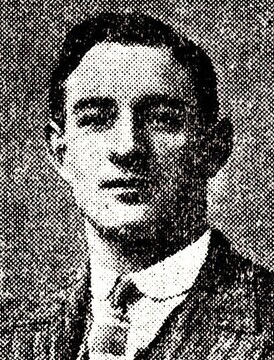
69013
RAPLEY, Reginald
| Service Numbers: | 766, 1137 |
|---|---|
| Enlisted: | 25 July 1914 |
| Last Rank: | Private |
| Last Unit: | 43rd Infantry Battalion |
| Born: | Godalming, Surrey, England, 1 June 1888 |
| Home Town: | Adelaide, South Australia |
| Schooling: | Not yet discovered |
| Occupation: | Bricklayer |
| Died: | Natural causes, Hilton, Western Australia, Australia, 5 September 1981, aged 93 years |
| Cemetery: |
Fremantle Cemetery, Western Australia Cremated - Ashes scattered to the winds at Fremantle Cemetery |
| Memorials: | Broken Hill Barrier District Roll of Honour, Broken Hill Wesley Uniting Church Memorial Windows, Elliston War Memorial |
World War 1 Service
| 25 Jul 1914: | Enlisted AIF WW1, Private, 766, 10th Infantry Battalion | |
|---|---|---|
| 29 Aug 1914: | Enlisted AIF WW1, Private, 766, 10th Infantry Battalion, at Morphettville | |
| 20 Oct 1914: | Involvement Private, 766, 10th Infantry Battalion, --- :embarkation_roll: roll_number: '10' embarkation_place: Adelaide embarkation_ship: HMAT Ascanius embarkation_ship_number: A11 public_note: '' | |
| 20 Oct 1914: | Embarked Private, 766, 10th Infantry Battalion, HMAT Ascanius, Adelaide | |
| 25 Apr 1915: | Involvement AIF WW1, Private, 766, 10th Infantry Battalion, ANZAC / Gallipoli | |
| 21 Mar 1916: | Discharged AIF WW1, Lance Corporal, 766, 10th Infantry Battalion, Medically discharged due to rheumatic fever | |
| 2 Jun 1916: | Enlisted AIF WW1, Private, 1137, 43rd Infantry Battalion, at Adelaide | |
| 9 Jun 1916: | Embarked AIF WW1, Private, 1137, 43rd Infantry Battalion, HMAT Afric, Adelaide | |
| 9 Jun 1916: | Involvement AIF WW1, Private, 1137, 43rd Infantry Battalion, --- :embarkation_roll: roll_number: '18' embarkation_place: Adelaide embarkation_ship: HMAT Afric embarkation_ship_number: A19 public_note: '' | |
| 14 Aug 1919: | Discharged AIF WW1, Private, 1137, 43rd Infantry Battalion |
Help us honour Reginald Rapley's service by contributing information, stories, and images so that they can be preserved for future generations.
Add my storyBiography contributed by Glenunga International High School
WWI (also known as the First World War, the Great War and the European War) began on July 28th, 1914 after the assassination of Archduke Ferdinand and lasted for four years until the 11th of November, 1918. It was one of the largest wars in history, 70 million military personnel from around the world were involved in it and over 10 million people died because of it. The Central Powers (Germany, Austria-Hungary and Turkey) were against the Allies (mainly France, Great Britain, Italy, Russia and later the United States). WWI ended with the Central Powers defeated and the Allies victorious.
The 10th Battalion was one of the first infantry units raised for the AIF (Australian Imperial Force) during WWI and was based in Adelaide, South Australia. The battalion embarked to Egypt just two months after being raised and later went to Gallipoli, where they were heavily involved with defending the front line until the evacuation in December. The 10th Battalion returned to Egypt and in March 1916, they embarked to France to fight on the Western Front in trench warfare until 1918. The Battalion continued to operate until late September, 1918 and began returning to Australia in November.
Reginald Rapley was born in Godalming, Surrey, England in 1888. He was not married and his next of kin was his mother, Mrs Mary Rapley. His occupation before enlisting was a bricklayer and he had been rejected once for joining the army because he was ‘medically unfit’ but also had 4 years of prior military service. Prior to enlisting for the army, he lived in Broken Hill, New South Wales.
He enlisted for the army on the 29th of August 1914 and embarked on the 20th of October 1914 from Adelaide, South Australia on board the Transport A11 Ascanius as a private. The battalion he was in at the time (10th battalion) left Australian waters before sailing to Egypt and staying at Mena camp, a vast training facility near the Pyramids of Giza and about 16 km from Cairo. Reginald Rapley embarked on the “Ionian” to join the MEF (Mediteranean Expeditionary Force) on the 2nd of March, 1915 and landed on Gallipoli on the 25th of April, 1915. That September he was diagnosed with influenza. He transferred to the No 1. ACCS (1st Australian Casualty Clearing Station) on the 10th of September and jumped between hospitals until the 2nd of October, 1915 due to his influenza. That same month on the 22nd he was diagnosed with Rheumatic fever and was transferred to base. Due to his illness, Reginald was returned to Australia and discharged on the 21st of March 1916.
Reginald re-enlisted in the 43rd Battalion on the 2nd of June 1916. In November 1916 he arrived in France. Few details are available of his later war service. He returned to Australia safely in 1919.










